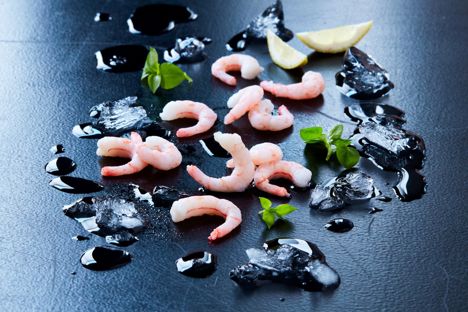
Ingredient focus: cold-water prawns
In the world of prawns most people assume that bigger is better. But, when it comes to the deliciously sweet cold-water prawns, looks can be deceiving. These smaller prawns pack a big punch of flavour, and are an extremely convenient ingredient for weeknight meals. We take a closer look at this overlooked and misunderstood staple of British kitchens.
Ingredient focus: cold-water prawns
In the world of prawns most people assume that bigger is better. But, when it comes to the deliciously sweet cold-water prawns, looks can be deceiving. These smaller prawns pack a big punch of flavour, and are an extremely convenient ingredient for weeknight meals. We take a closer look at this overlooked and misunderstood staple of British kitchens.
Cold-water prawns are a familiar sight to almost everyone in the UK. They can typically be found frozen and shelled at supermarkets, or mixed with a marie rose sauce in a prawn sandwich or prawn cocktail. Despite their enduring popularity and deliciously sweet flavour, many people are unaware that cold-water prawns are not just immature or small king prawns; they are in fact an entirely different species, found exclusively in the wild.
As the name implies, cold-water prawns (Pandalus borealis) thrive in the freezing cold North Atlantic and Arctic Oceans. Unlike many types of prawn, they are never farmed and have a sweeter, juicier texture than their better known king prawn cousins. The distinctively small size of cold-water prawns is due to the extreme, icy conditions where they’re found, which leads to them growing and maturing incredibly slowly. It takes a cold-water prawn five years to get to just ten grams, and six to eight years to reach maturity. In contrast, a farmed king prawn can grow to thirty grams in under a year, and is fully mature at just six months. It is this slow growth which gives the cold-water prawn its sweet and intense flavour.
Seafood experts Royal Greenland, who carry out both ‘in-shore’ and ‘off-shore’ prawn fishing, catch their prawns at around six years, when they are about ten centimetres long. The prawns caught by in-shore fishing boats close to the Greenland coastline, are packed on ice at sea and then cooked and shelled on land. In contrast, off-shore fishing requires the use of large trawlers that spend weeks at sea, meaning that the prawns caught off-shore are cleaned, sorted and frozen on board the trawler. In fact, Royal Greenland’s fisherman can take the prawns from the net to the freezer in as little as 20 minutes, ensuring maximum freshness.
Royal Greenland adapts their preparation of prawns to different markets, since each country likes its prawns a slightly different way. In Japan - where cold-water prawns are known as amaebi, or ‘sweet prawns’ due to their flavour - prawns are typically sold whole and raw. In the UK, there is more of a market for cooked and shelled prawns, whereas in Sweden consumers prefer prawns to have their shell on.
Prawns aboard Royal Greenland’s ships are mostly ‘Individually Quick Frozen’ (IQF). This allows the prawns to be frozen almost instantly, which protects their texture and ensures that they are just as juicy as when they were caught. It also means that each prawn is individually coated in a very thin layer of ice, rather than being stuck together in a block.
As for the sustainability credentials of cold-water prawns, all of Royal Greenland’s cold-water prawn fisheries in Greenland and Canada are MSC (Marine Stewardship Council) certified. This means that Royal Greenland is certified as fishing at a rate that is sustainable for fish stocks, that they protect cold-water prawns’ ecosystem, and that they will adapt their behaviour as needed to maintain sustainability. Royal Greenland’s fisheries are inspected regularly by the MSC to ensure that they continue to be managed in an environmentally responsible manner, and meet MSC’s high standards.
Most cold-water prawns available in the UK are frozen. If using frozen prawns, always make sure to fully defrost them before adding them to recipes. The best way to defrost prawns is to thaw them in the fridge overnight. This will ensure that the delicate firm texture and delicious flavour remain intact.
There is a reason why cooked cold-water prawns are most popular in dishes which are served at room temperature: they are at their best and sweetest when simply defrosted and mixed with a sauce or dressing. We have a range of recipes perfect for cold-water prawns - including classic prawn cocktails, Vietnamese summer rolls and potted prawns. If you do add cooked cold-water prawns to a hot dish, use them in one where they will only be cooked very briefly - for example, in prawn and smoked salmon ravioli - or where they only need to be added right at the very end, such as in a seafood risotto.
Cold-water prawns have long been a favourite in the UK. Through their commitment to sustainable fishing and careful preparation of the prawns, Royal Greenland are ensuring that British consumers can continue to enjoy high quality cold-water prawns for many years to come.


